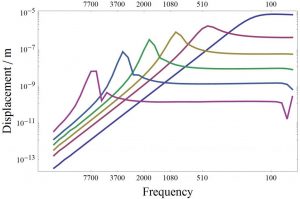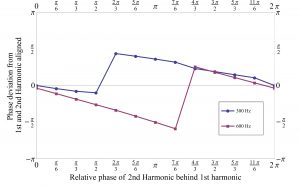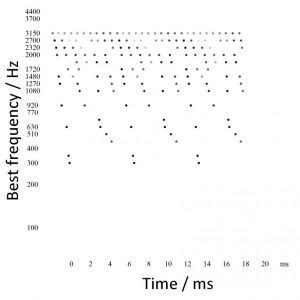In the cochlear of the human ear the sound waves are translated from acoustical waves into neural electrical spikes. Within this transformation process synchronization happens. When a musical sound enters the cochlear it brings the basilar membrane into vibrations. At certain points on the basilar membrane a maximum amplitude is reached. Below are examples of the maximum amplitudes along the basilar membrane for different frequencies:

When a musical tones with several harmonic overtones enters the ear the different overtones are separated according to the maximum amplitude position on the membrane. Each overtone can have any phase, any temporal relation with respect to all other overtones. Still when all are present at the same time on the basilar membrane these phases are aligned, they are synchronized. When the phase of a fundamental is kept constant and the phase of a first overtone is changed through a whole phase the output phases of the two frequencies are aligned:

When looking at the cochleogram, a plot showing at which position on the basilar membrane (vertical-axis) at which time point (horizontal axis) a spike is produced, and when inserting a harmonic overtone series with random phase relations, the output nevertheless shows time synchronized spikes:

This means that the spike train leaving the cochlear already on this level shows a strong coincidence detection, an alignment of spikes at a time point.
This is interesting in terms of musical instrument sound production and perception. Musical instruments have clear aligned phases of overtones, which are impulses traveling along strings or tubes. Still when radiated, these impulses are strongly blurred. The ear (and later the brain) is again aligning these blurred phases reconstructing the impulses present in the musical instruments.
Lit.:
Bader, R.: Phase synchronization in the cochlea at transition from mechanical waves to electrical spikes, Chaos 25, 103124, http://dx.doi.org.1757.emedien3.sub.uni-hamburg.de/10.1063/1.4932513, 2015.
Bader, R. & Mores, R.: Cochlear detection of double-slip motion in cello bowing. arXiv:1804.05695v1 [q-bio.NC] 16 Apr 2018.
Bader, R.: Cochlear spike synchronization and coincidence detection model. Chaos 023105, 1-10, 2018.
